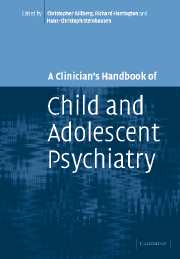Book contents
- Frontmatter
- Contents
- Preface
- List of contributors
- 1 Brain disorders
- 2 Substance use disorders
- 3 Schizophrenia and schizophrenia-like disorders
- 4 Affective disorders
- 5 Anxiety disorders
- 6 Obsessive-compulsive disorders
- 7 Adjustment disorders
- 8 Post-traumatic stress disorder
- 9 Functional somatic symptoms and somatoform disorders in children
- 10 Eating disorders: anorexia nervosa and bulimia nervosa
- 11 Sleep disorders
- 12 Personality disorders
- 13 Mental retardation/learning disability
- 14 Specific developmental disorders of speech and language
- 15 Reading and other learning disorders
- 16 Autism spectrum disorders
- 17 Hyperkinetic disorders
- 18 Conduct disorders
- 19 Elective mutism
- 20 Attachment and disorders of attachment
- 21 Tic disorders
- 22 Elimination disorders: enuresis and encopresis
- 23 Physical and sexual abuse
- 24 Gender identity disorders
- Index
- References
11 - Sleep disorders
Published online by Cambridge University Press: 06 August 2009
- Frontmatter
- Contents
- Preface
- List of contributors
- 1 Brain disorders
- 2 Substance use disorders
- 3 Schizophrenia and schizophrenia-like disorders
- 4 Affective disorders
- 5 Anxiety disorders
- 6 Obsessive-compulsive disorders
- 7 Adjustment disorders
- 8 Post-traumatic stress disorder
- 9 Functional somatic symptoms and somatoform disorders in children
- 10 Eating disorders: anorexia nervosa and bulimia nervosa
- 11 Sleep disorders
- 12 Personality disorders
- 13 Mental retardation/learning disability
- 14 Specific developmental disorders of speech and language
- 15 Reading and other learning disorders
- 16 Autism spectrum disorders
- 17 Hyperkinetic disorders
- 18 Conduct disorders
- 19 Elective mutism
- 20 Attachment and disorders of attachment
- 21 Tic disorders
- 22 Elimination disorders: enuresis and encopresis
- 23 Physical and sexual abuse
- 24 Gender identity disorders
- Index
- References
Summary
Introduction
Sleep disorders in psychiatry
Sleep disorders is not simply a topic comparable to schizophrenia or dissociative disorders. The term covers a very wide range of conditions of diverse aetiology. ‘Sleep disorders medicine’ is now a multidisciplinary specialty in its own right based on approaches and information from general medicine and paediatrics, child and adult psychiatry, neuropsychiatry, psychology (including developmental aspects) and several other disciplines and specialties. Sleep disorders are by no means only relevant to psychiatry, although there are various important links between them and clinical practice in psychiatry, whatever the age of the patient.
The main connections of this type are as follows.
Disturbed sleep is a very common feature of many psychiatric disorders in children, adolescents and adults.
Sleep disturbance is known to be an early sign of serious psychiatric disorder or threat of relapse which, if recognized, might have important preventive value.
Various psychotropic medications are associated with poor sleep, possibly adding to the patient's coping difficulties.
Sleep disturbance can affect mood, behaviour, cognitive abilities and performance.
If severe, such disturbance may cause psychiatric disorder. At least a contributory role has been suggested for some forms of adult depression, and cases of both child and adult attention deficit hyperactivity disorder (ADHD) have been described as a consequence of a primary sleep disorder.
Some sleep disorders may well be mistaken for primary psychiatric conditions because of similarities in clinical presentation, but also as a consequence of clinicians' limited familiarity with the range and manifestations of sleep disorders.
The requirement for reviews such as the following that, as far as possible, statements should be ‘evidence based’ requires consideration.
- Type
- Chapter
- Information
- A Clinician's Handbook of Child and Adolescent Psychiatry , pp. 304 - 338Publisher: Cambridge University PressPrint publication year: 2006
References
- 5
- Cited by



